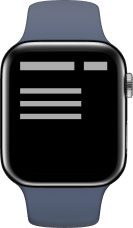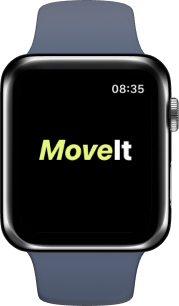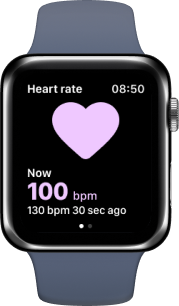
MoveIt
A workout app for mobile and smartwatch.
MoveIt is designed for busy users who need quick, effective workouts and seamless health tracking. This project involved designing both a mobile app and a smartwatch companion, helping the user stay consistent, motivated, track progress, and maintain heart health on a tight schedule.
Make workouts easy, motivating and accessible, anytime and anywhere.
Project overview
Welcome to MoveIt!
MoveIt is a workout app that seamlessly integrates both mobile and smartwatch to help busy, dedicated, and hard-working users stay consistent with their workouts.
MoveIt focuses on quick, equipment-free workouts, real-time progress tracking, and cross-device syncing. By combining mobile and smartwatch, MoveIt empowers users to manage their workout routines effortlessly, no matter how busy their schedules. The goal is simple: Make workouts easy, motivating, and accessible, anytime, anywhere.
-
MoveIt – A fitness tracking app for busy professionals.
-
Noroff (educational project).
-
1 week (march 2025).
-
UX/UI designer.
-
Kristina Klafstad (individual project).
-
Figma, FigJam
Problem
Busy professionals often struggle to maintain a consistent workout routine. Existing apps are either too complex or not optimized for use on multiple devices like smartphones and smartwatches.
Challange
How can we create a dual-device fitness solution that supports quick workouts, tracks health data, and keeps users motivated—all within a tight daily schedule? The smartwatch and mobile app should also work differently, but at the same time work seamlessly together.Solution
MoveIt is a connected mobile and smartwatch app that enables quick workout logging, real-time heart rate monitoring, and daily planning. Designed with an emphasis on simplicity, accessibility, and seamless syncing across devices.
The design thinking process
Empathize
Define
Ideate
Prototype
Test
Empathize and define
The Empathize phase started by looking for inspiration and other examples of similar products to get me thinking through the entire design process and to get some ideas on how to solve the MoveIt solution. Then I empathized with the persona Jarno Lindeman’s busy life and tech-savvy nature to define the problem. The persona guided the project from start to finish, with special attention to stress, time constraints and motivation. A contextual scenario was written to simulate how Jarno would realistically use the app – both on mobile and smartwatch. User flows was created based on the contextual scenarios and illustrate when Jarno uses his smartwatch and the mobile app to search and find a suitable workout, start and finish the workout and see that the workout was saved.
First of all, some visual research should have been done, such as conducting a competitive analysis or SWOT. This would have been useful to show the current market and how others function, look and are designed to better inform your own work.
-
Jarno is a busy design manager who struggles to maintain a consistent workout routine due to his packed schedule. He needs the MoveIt app, which seamlessly integrates with his smartwatch and mobile phone, so he can quickly start workouts, track heart health and receive reminders – helping him remember to workout, stay motivated and on track.
-
Jarno Lindeman.
Age: 42
Family: Divorced, one adult child
Occupation: Design Manager
Location: Berlin, Germany
Devices: Apple iPhone 16 Plus, Apple Watch 44 mmBio
Jarno is a focused and driven design manager who balances a demanding job with a desire to stay healthy. He lives in Berlin but is always on the go — whether he travels for work, attends meetings, or works from his mobile phone. Despite his busy schedule, Jarno is committed to improving his fitness and heart health. He prefers simple workouts that he can do at home or even in a hotel room. Jarno is tech-savvy and efficient, and values intuitive apps that sync seamlessly across his devices.Personality
More focused then unfocused.
More self-motivated then unmotivated.
More driven then Unambitious.
More organized then unorganized.
More tech-savvy then non-technical.Goals
Exercise more consistently.
Track heart rate over time.
Pain points
Often forget to exercise due to a busy schedule.
Always on the go.
Needs
To do workouts wherever he is without any equipments.
Get more information about health and fitness.
Reminders on the Apple Watch to keep his exercise routine more consistent.
Seamless sync between Apple Watch and mobile app for easy tracking.
Motivations
Gain strength with simple home workouts.
Improve hearth rate.“I want to gain strength with simple home workouts to improve my heart health.”
-
Persona: Jarno Lindeman.
Scenario: Interaction with smart watch and mobile device.07:30 – Good morning!
Jarno starts a slightly stressful working day from home with a cup of coffee while scrolling through e-mails on his iPhone. He glances at his smartwatch, which shows his resting heart rate—a reminder from the MoveIt app to pay attention to his health. Curious, he checks the resent heart rate trends on his watch and notices that it has been higher than usual.08:30 – Quick workout
Jarno sees that he has time for a 15-minute workout session before a video meeting at 09:00. He opens the MoveIt app on his iPhone and taps "Workout". He knows the time is short, and types "quick" into the search field. He gets several suggestions but chooses "quick full body burn" - a 15-minute workout that requires no equipment. Perfect, Jarno thinks, ready as an ox to sweat a little. With a tap on "Start workout", his smartwatch buzzes gently on his wrist. MoveIt on the iPhone has synchronized with his watch, showing the name of the workout, time, calories and heart rate.08:35 – Quick workout in progress
An instructional video shows in full-screen mode on his iPhone. As Jarno follows the workout, he occasionally glances his watch to monitor his heart rate and calories burned – a simple way to stay on track without breaking his rhythm.08:50 - Workout complete!
Quick full body burn - done! A success message on the iPhone confirm that the workout session is complete and saved. The smartwatch on Jarno's wrist vibrates again, and a summary of the workout session confirms his efforts here as well.12:00 – Progress review and planning
During his lunch break at 12:00, Jarno receives a notification from the MoveIt app on his iPhone asking if he wants workout reminders to help him stay motivated, he taps “yes”, as he is often so busy that he forgets to exercise. At the same time, he also takes the time to review this morning’s workout stats and feels satisfied with the result. He also scrolls through some workouts he finds motivating and saves them for quick access later. He then plans a 30-minute jog for the evening.19:00 – Reminder and end of the day
A long working day is over. Jarno’s watch buzzes: Jog at 19:45. He had completely forgotten, so the reminder is a welcome nudge. He invites his 20-year-old son to join him. During the jog, the MoveIt app tracks steps and heart rate in the background, and he also occasionally checks his watch for real-time updates on his heart rate, time and calories burned. Jarno enjoys the workout and the quality time spent outdoors with his son – a perfect way to end the day. -
The scenario shows how MoveIt supports Jarno's workout journey by combining quick, immediate data on the smartwatch with in-depth tracking and planning on his mobile app.
-
Based on the contextual scenario, user flows were developed for both mobile and smartwatch.
Ideate
The ideation phase focused on generating creative solutions for the MoveIt mobile and smartwatch app. The process began with "How Might We" (HMW) questions to spark the brainstorming. With accessibility principles in mind, I was also thinking about how to use colors and fonts for readability, due to users with visual or motor impairments.
A mind map was created to more easily visualize and understand the content and structure of each screen. Paper sketches were then developed for both devices and critiqued through a dot-voting session to choose the best idea to move forward with. Ideally, I should have used NUF convergent thinking, just to prioritize ideas.
-
-
Paper sketches were developed for both devices and critiqued through a dot-voting session to choose the best idea to move forward with.
Prototype
•
Prototype •
Low-fidelity prototypes
After sketching and choosing the best ideas to move forward with, low-fidelity prototypes of both apps and screens were created that meet the brief's requirements. This helped define the user journey and information hierarchy.
-
Using the mobile app, Jarno should be able to:
Search and find a suitable workout (e.g., chest workout).
Start the workout (see an introductory screen).
Do the work out (see some instructions on one screen).
Complete the workout (details will be saved e.g., time taken, heart rate).
See his resting heart rate over time (days, weeks, and months).
-
Using the smartwatch app, Jarno should be able to:
View the workout name (e.g., chest workout) and expected duration in minutes (e.g., 35 minutes).
Check the calories that will be burned (e.g., 250kcal).
See his resting heart rate over time (24 hour day period).
In terms of requirements, the smartwatch and mobile app work differently, but they work seamlessly together. The smartwatch app is designed to display glanceable content, such as viewing workout progress or checking calories, while the mobile app provides more detailed content with a more complex UI design. I considered how to design a smooth transition between devices and the interaction design (gestures). The goal was to keep both apps consistent in terms of interaction patterns for a smooth user experience. Since the smartwatch app can’t do everything the mobile app can, I also considered the interaction between devices and the navigation for each device type.
Mobile
Splash
Home screen
Finds workout
Start workout
Workout progress
Workout progress
Workout completed
Resting heart rate over time
Smartwatch
Splash
Workout information
Workout progress
Pause/resume
Workout summary
Heart rate
Resting heart rate
Search workout
Workouts screen

High-fidelity prototypes
Once I was confident with the low-quality prototypes, I upgraded them to a high-fidelity interactive level. The design ensures consistency between the mobile and smartwatch apps, emphasizing a seamless user experience with clear visual hierarchy and intuitive interactions like taps and swipes on the go. Clear labeling and navigation, filled clickable cards, bright colors, good contrast, text sizes, and large touch targets contribute to good accessibility.
Mobile
Splash
Home screen
Finds workout
Start workout
Workout progress
Workout completed
Resting heart rate over time
Smartwatch
Splash
Workout information
Workout progress
Pause/resume
Workout summary
Heart rate
Resting heart rate
Search workout
Workouts screen
Conclusion
The MoveIt app will make Jarno’s workout routine more regular, consistent, and easy. The app displays the most important information on the smartwatch, and more detailed information on the mobile phone. The app offers Jarno both quick workouts and real-time progress monitoring.
The design process has focused on accessibility such as high-contrast colors, easy-to-read text, and large touch targets for users with visual or motor impairments. Interaction design principles have been taken into account to ensure consistency in the design, using familiar gestures such as taps or swipes.
Overall, both the smartwatch and mobile app work seamlessly together with smooth transitions. The smartwatch app is designed to display content that is glanceable, such as progress in a workout or checking calories, while the mobile app provides more detailed content with a more complex UI design.
Test
Usability testing was not a requirement in this project, but it should be part of the next steps:
Improve hi-fi prototypes based on stakeholder feedback.
Conduct usability testing to gather insights and identify pain points.
Improve user interface elements, interactions, and overall functionality based on test findings.

































